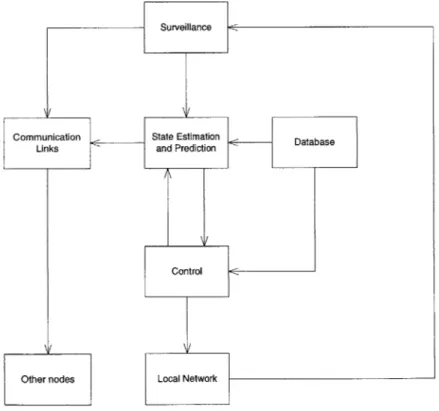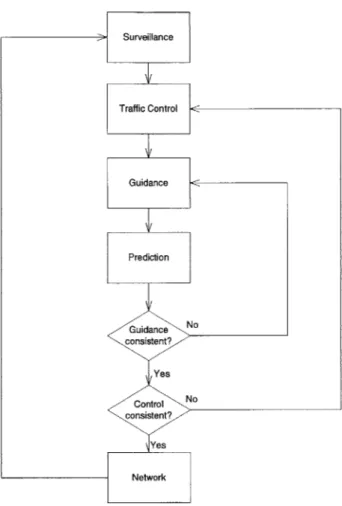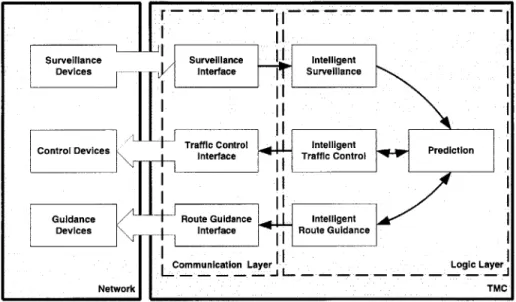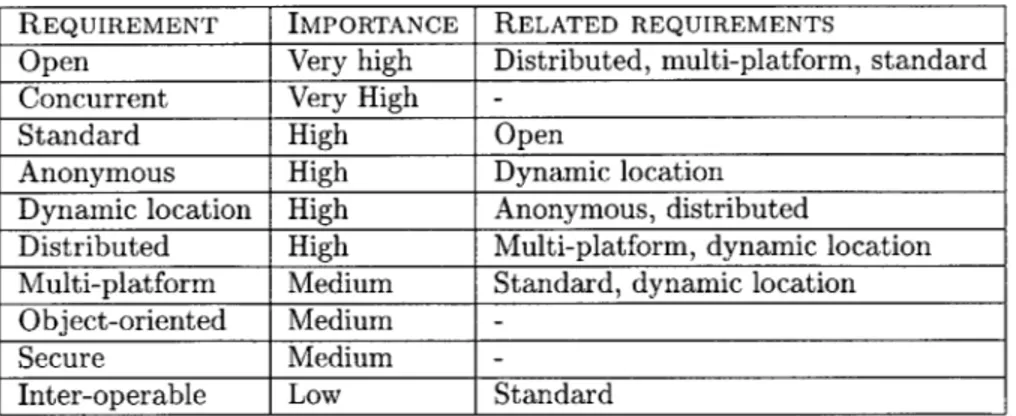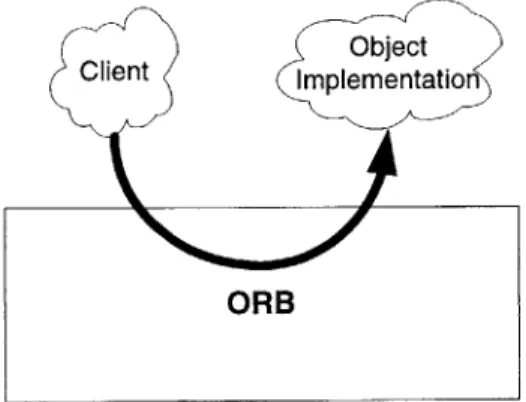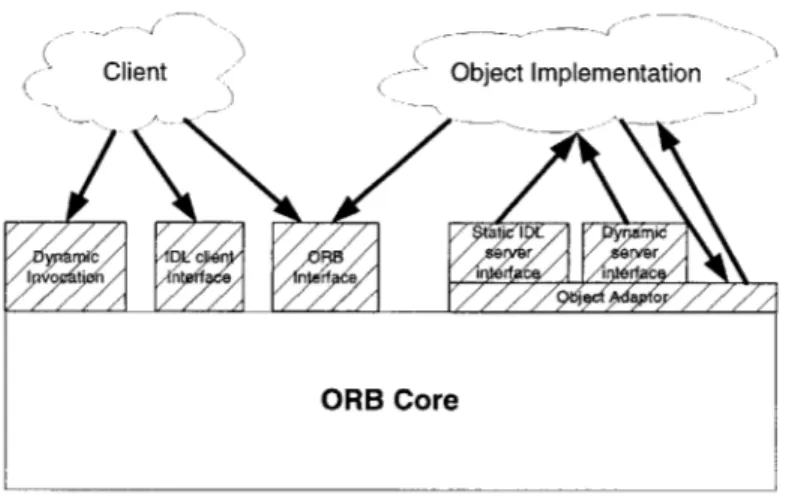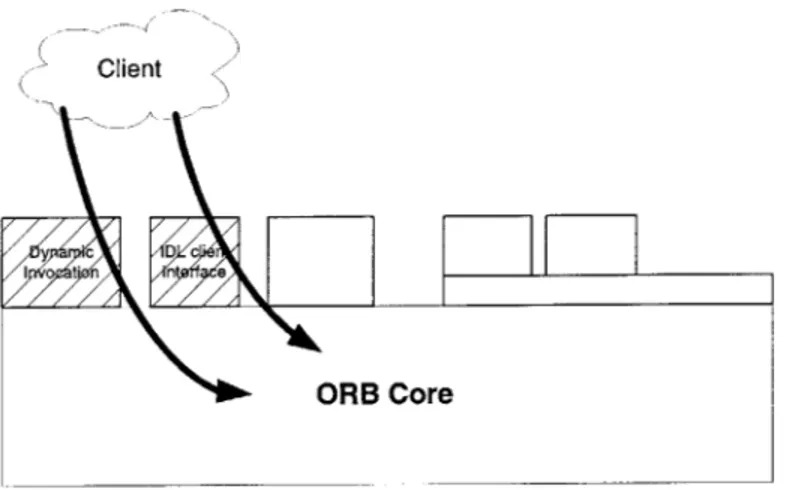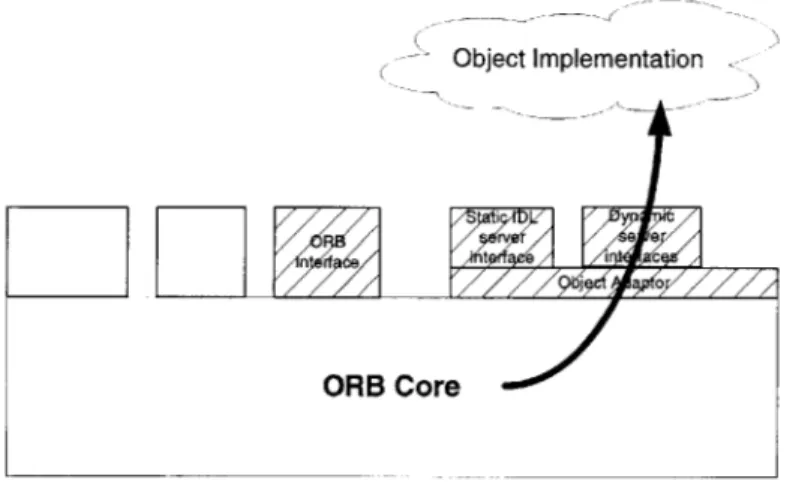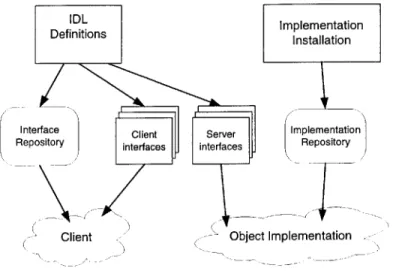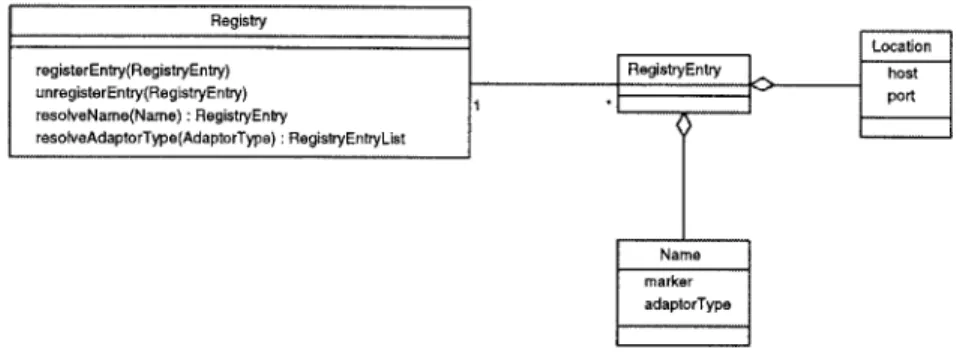Architecture for the Integration of Dynamic
ENG
Traffic
Management Systems
ASSACHSEnS INSTITUTIby
OF TECHNOLOGYBruno Miguel Fernandez Ruiz
MA
2YB.S. Tniversidad Politkcnica de Madrid (1997) LIBRARIES
Submitted to the Department of Civil and Environmental ngineerin
in partial fulfillment of the requirements for the degree of
Master of Science in Transportation
at the
MASSACHUSETTS INSTITUTE OF TECHNOLOGY
June 2000
®
Massachusetts Institute of Technology 2000. All rights reserved.
Author
...
Departmet of Civil and Environmental Engineering
March 31, 2000
Certified by...
Moshe E. Ben-Akiva
Edmund K.Turner Professor of Civil and Environmental Engineering
Thesis Supervisor
C ertified by ...
-...--- ...
Didier Burton
Research Affiliate, Center for Transportation Studies
Thesis
Supervisor
C ertified by ... -.-..-..-..-.--.--.--.- ..- ..-.
Haris N. Koutsopoulos
Operations Research Analyst, Volpe National Transportation System
Center
Thesis Supervisor
A ccepted by ....
.
.
-
-..
--..
--..
--..
--..--.
Architecture for the Integration of Dynamic Traffic
Management Systems
Bruno M. Fernandez Ruiz
Submitted to the Department of Civil and Environmental Engineering on March 31, 2000
in partial fulfillment of the requirements for the degree of Master of Science in Transportation
Abstract
Dynamic Traffic Management Systems (DTMS) are intended to operate within Traffic Management Centers (TMC) to provide pro-active route guidance and traffic control support. The integration of multiple DTMS software systems requires the modification of the structure and design of the TMCs where they will be integrated. An open, scalable and parallel system architecture that allows the integration of multiple DTMS servers at minimum development cost is presented in the current research. The core of the architecture provides: a generic distribution mechanism that extends the Common Object Request Broker Architecture (CORBA); a generic creation mechanism based on the Abstract Factory pattern that permits an anonymous use of any DTMS within TMCs; and a generic naming mechanism (Registry) that allows the TMC to locate the DTMS servers in remote hosts without using any vendor specific mechanism. Finally, the architecture implements a Publisher/Subscriber pattern to provide parallel programming on top of the CORBA's basic synchronous communication paradigm.
This system architecture is used to propose TMC application designs. The system architecture was validated in a case study that showed the integration of DynaMIT, a prediction-based real-time route guidance system with MITSIMLab, a laboratory for the evaluation of Dynamic Traffic Management Systems. MITSIMLab includes a Traffic Management Simulator (TMS) that emulates the TMC operations. DynaMIT was integrated within TMS using the proposed system architecture.
The core of the system architecture was distributed under CORBA using IONA Technologies Orbix 2.0 Object Request Broker, and it was implemented in C++ using the object-oriented paradigm.
Thesis Supervisor: Moshe E. Ben-Akiva
Professor of Civil and Environmental Engineering Massachusetts Institute of Technology
Thesis Supervisor: Didier Burton
Research Affiliate, Center for Transportation Studies Massachusetts Institute of Technology
Thesis Supervisor: Haris N. Koutsopoulos Operations Research Analyst
Acknowledgments
I am really thankful to Professor Moshe Ben-Akiva for his guidance, support, and
insights through my graduate study. My heartfelt gratitude also goes to Dr. Didier Burton and Dr. Haris Koutsopoulos for leading me the way along my research.
I would like to express my gratitude to the Oak Ridge National Laboratories,
the Federal Highway Administration for their financial support. My thanks also go to MIT's Department of Civil and Environmental Engineering and the Center for Transportation Studies for their graduate program.
I consider myself very fortunate for having pursued my graduate study at MIT. My experience at MIT however goes well beyond education. If I had to tell which
is the most important lesson I have learned here, getting to know new people would definitely be it. Along the last two years I have developed very intense friendships with outstanding people to whom I will always be in debt. Each of them gave me hints, and made me look at different ways of understanding life. These friendships will last forever and the experience will lead our paths through life. Among these friends are Tomer, Masroor, and Mathew, and all my other fellows from the ITS Program; and Hilton, Wendy, Tatsuo, Maria-Carla, Peter, Coralie, Markus, and Michael, and all others from my beloved Wednesday dinners.
Of course, this journey would not have been possible without the love, time and
support of Inge, my girlfriend, to whom I will always be grateful.
Finally, my thanks to my parents for giving me the chance to receive a good education and, most of all, for making me feel loved all the time. They have given me the greatest of all gifts: amor.
Contents
1 Introduction
1.1 Dynamic Traffic Management Systems 1.2 TMCao 1.2.1 1.2.2 1.2.3 1.2.4 1.2.5 1.2.6 1.3 Resear 1.4 Literat 1.4.1 1.4.2 1.4.3 1.4.4 1.5 Thesis verview . . . . Surveillance Systems . . . . Control Systems . . . . Incident Management Systems . . . . Decision Support Systems . . . . Other Systems . . . .
Computing Environments . . . .
ch O bjective . . . .
ure review . . . .
Dynamic Traffic Control . . . . Prediction-based (Dynamic Traffic Assignment) Dynamic Traffic Management Systems . . . .
TMC architectures . . . . outline . . . . 2 Requirements 2.1 TMC subsystems description 2.1.1 Communication Layers 2.1.2 Logic Layers . . . . 2.2 Architectural requirements . . . 11 11 12 14 14 15 15 16 16 17 19 20 21 23 24 26 28 28 30 31 33 ATIS
3 System Architecture
3.1 Distributed Object Computing.
3.2 Distributed Systems Technology
3.2.1 Sockets . . . . 3.2.2 HTTP/CGI . . . . 3.2.3 CORBA . . . . 3.2.4 DCOM . . . . 3.2.5 RM I . . . . 3.2.6 Conclusion . . . . 3.3 CORBA overview . . . . 3.4 CORBA extensions . . . . 3.4.1 Inter-operability . . . . 3.4.2 Concurrent programming. 3.5 System distribution . . . . 3.5.1 3.5.2 3.5.3
Four-layer client/server distribution Three-tier distribution . . . . TMC system architecture . . . . . 38 38 39 40 40 41 42 43 44 44 48 49 56 64 65 67 71 76 76 78 79 80 84 4 Application design
4.1 Integrated TMC system design . . . .
4.1.1 Centralized system, single region . . . .
4.1.2 Decentralized system, multiple regions 4.2 Other applications of the proposed architecture 4.3 Conclusion . . . .
5 Case Study 85
5.1 R equirem ents . . . . 85 5.2 M ITSIM Lab . . . . 86 5.3 D ynaM IT . . . . 90
5.4 Implementation of the integration of DynaMIT in MITSIMLab . . . . 94
. . . . . . . .
6 Conclusions 100
6.1 Research Contribution . . . . 100
6.2 Future W ork . . . . 101
A UML Object diagram 107
B Object definition files 108
List of Figures
1-1 Generic Traffic Management Node . . . . 1-2 Iterative prediction/control/guidance procedure . . . . . 2-1 Connection and Logic Layers of a TMC . . . .
23 25 29
3-1 A request being sent through the Object Request Broker . . . . 44
3-2 The structure of Object Request Broker interfaces . . . . 45
3-3 A Client using the Stub or Dynamic Invocation Interface . . . . 46
3-4 An Object Implementation Receiving a Request . . . . 47
3-5 Interface and Implementation Repositories . . . . 48
3-6 The Registry pattern . . . . 53
3-7 The Factory pattern . . . . 56
3-8 The Source/Listener pattern . . . . 60
3-9 The Source/Channel/Listener pattern . . . . 62
3-10 Four-layer distribution architecture . . . . 66
3-11 Client/server distribution architecture . . . . 68
3-12 Three tier distribution architecture . . . . 70
3-13 Integrated TMC distribution architecture . . . . 73
4-1 TMC design: connection of two systems . . . . 77
4-2 TMC design: centralized system, single region . . . . 78
4-3 TMC design: decentralized system, multiple regions . . . . 79
4-4 TMC design: static system with ATMS/ATIS . . . . 81
4-6 Multiregional simulation . . . .8
5-1 Structure of MITIMSLab . . . . 87
5-2 TMS: proactive traffic control and routing systems . . . . 89
5-3 Structure of DynaMIT . . . . 91
5-4 DynaMIT: Illustration of the rolling horizon . . . . 92
5-5 Integration of DynaMIT into MITSIMLab: system design . . . . 95 83
Chapter 1
Introduction
In the last decade, research in Intelligent Transportation Systems (ITS) has led to the development of various tools for the optimization of transportation systems.
ITS has concentrated some of its efforts on the study of road traffic. Currently,
several ITS technologies intended to achieve efficiency in the management of traffic operations are being developed. These technologies are based on complex software systems implemented in the Traffic Management Centers (TMCs). Advanced Traffic Management Systems (ATMSs) and Advanced Traveler Information Systems (ATISs) are the two main ITS technologies currently being developed. The use of both technologies in TMCs will lead to advanced traffic management with dynamic route guidance and traffic control in the future. However, the introduction of such diverse software systems poses difficult problems for issues of system integration, data communication, interfacing , and synchronization, among others. The study of these difficulties and the possible solutions is the basis of this work.
1.1
Dynamic Traffic Management Systems
Dynamic Traffic Management Systems (DTMSs) are designed to support the operations of TMCs. They are the latest generation of support systems and all internal operations are generally performed in a completely automated way. DTMS are dynamic: the management of the traffic network is based on proactive strategies
as opposed to reactive strategies. Predicted conditions constitute the basis upon which these proactive systems generate strategies. Predicted conditions are used to
generate route guidance and traffic control.
There is a very strong coupling between traffic control and route guidance, both in the modeling level as well as the physical level. The modeling issues are partially reviewed in 1.4. The physical issues include communication networks, system interfaces, database management, etc.
DTMSs may have varying levels of automation. At the most automated level, all operations (data collection, data processing, decision support, and data dissemination and execution) are performed by a group of software elements. DTMS must interact in real-time among themselves and with the other systems in the TMC. This requires the TMC to provide an open communication architecture that allows the integration of all core systems and DTMSs.
1.2
TMC overview
A TMC consists of multiple ITS systems: some core systems (e.g. the Surveillance
System), and some interfaced systems (e.g. a Route Guidance System). The core
systems provide the basic set of functionality needed to operate a TMC (collecting surveillance data, controlling signals, and coordinating incident response). The core systems are usually legacy1 systems designed for a custom TMC. The TMC basic functionality is enhanced with the addition of interfaced systems (e.g. real-time adaptive traffic control, route guidance, etc.) The TMC must provide the necessary interfacing capabilities. Namely, the TMC must provide:
9 A system architecture that allows the integration of all systems. The
architecture must encapsulate the custom nature of the TMC's core systems, so that any additional system can be easily plugged in.
'In the IT industry, the term legacy system is used to design an antique system, normally that does not have public interfacing capabilities.
" Interfaces to other ITS components, such as Advanced Traveler Information Systems (ATIS).
" Interfaces to non-ITS components, such as police, fire and local organization. " A unified database structure to support the integration, operating efficiency,
and interface to other systems.
The fact that different TMCs may have different number of core systems suggests that the design of a generic TMC system architecture that allows the integration of any DTMS should provide encapsulation mechanisms to hide the custom nature of the core systems. These encapsulation mechanisms are provided through a series of interfaces. To obtain the maximum flexibility out of the system architecture, every system should have an interface.
A thin interface locates all the functionality in the subsystems, leaving the clients
with a minimum shell, most of the times a Graphical User Interface. This provides freedom and expandability to the system interaction, because the functionality is finely distributed among many small systems. A fat interface locates more
functionality in the clients and somehow reliefs the load of the server systems. This limits expandability, but it is easier and less risky to develop. The ideal interface will be somewhere in between: it is determined by finding the minimum functionality that the system must provide to the TMC, and then finding a compromise in terms of development risk and system expandability.
In order to design the required interfaces it is therefore important to identify and describe the functionality of the subsystems the TMC may consist of.
FHWA (1993) reviewed the state-of-the-practice of several TMCs and identified some of the desirable objectives:
" Collection of real-time traffic data and area-wide surveillance and detection.
* Integrated management of various functions including demand management, toll collection, signal control, and ramp metering.
* Rapid response to incidents and collaborative action on the part of various transportation management organizations to provide integrated responses.
* Proactive traffic management strategies including route guidance and pre-trip planning.
Of these issues, the first has already been deployed in TMCs; while the latter
three have been implemented but not yet deployed.
1.2.1
Surveillance Systems
Traffic surveillance is an essential TMC system. Traffic information is collected using a variety of technologies: loop detectors, video detection, infrared sensors, vehicle probes, aerial surveillance, etc. The information is captured by the sensors, processed locally, and aggregated for transmission to the TMC. Regular scanning frequencies are 1/240s and broadcasting frequencies are in the order of 1 or 2 seconds.
1.2.2 Control Systems
One of the fundamental properties of a TMC is the capability for controlling a traffic network. Control may be centralized, distributed, or hierarchical. In a centralized environment, a central facility collects traffic status data and makes traffic control decisions. In a distributed environment, control is performed locally, generally at the intersection level. A hierarchical control configuration is a hybrid between central and distributed control. In this architecture, control is generally performed locally; control decisions are monitored by a central facility that may override local control to achieve optimized traffic flow on a sub-region basis.
Regardless of the specific architecture, the vision is for integrated, proactive control rather than reactive control. Proactive control requires the support of a prediction system. A wide range of options is available for the control, including real-time traffic adaptive signal control, adaptive freeway control including ramp metering, transit and emergency vehicle preferential treatment, and lane usage control.
For most control system configurations, the control software will reside within the TMC as one of the support systems. In the case of distributed control, the TMC functions as a supervisory node with control override capabilities. The design and
redesign of TMCs needs to be sufficiently robust to accommodate variations of the architecture.
1.2.3
Incident Management Systems
One of the primary goals of ITS is to reduce congestion. Since a significant portion of traffic congestion is due to traffic accidents and other incidents, a primary functional requirement of a TMC is the detection and management of incidents. Because of the importance of this function, it is generally treated separately, although it involves elements of surveillance, monitoring, control, and decision support.
Certain information processing capabilities are required for the TMC to provide incident management. These include: integrated data management, real-time traffic model execution, image processing for area-wide surveillance and incident detection, and man/machine interfaces providing transparent access to needed information.
1.2.4
Decision Support Systems
Decision Support Systems extend the TMC's traffic control capabilities to support the decisions operators at TMCs have to make. All of the traffic models and simulations used in the TMC reside in the Decision Support System. Online models are used for developing response strategies. They must execute faster than real-time so that their results can affect decision-making processes occurring in real-time.
FHWA (1993) interviewed the managers from the most important TMCs in the
U.S. The requirements for Decision Support Systems that the managers suggested
included the following:
" Expert systems to aid in incident detection and management. " Access to traffic simulation models.
* Evaluation models to support route diversion and route guidance.
Thus, existing traffic simulation models are not used online for three reasons: most models are extremely data-input intensive; the data structures in the models do
not correspond to the structures in the TMC databases; some of the network models cannot be executed and analyzed within the time frame available for decision making. Currently there are no methods for the real-time evaluation of route diversion and route guidance strategies.
The overall scarcity of online models results from the fact that existing models have been developed for offline use and are difficult to integrate within an online environment.
1.2.5
Other Systems
ATMS is the core of ITS. As such, it is the integrating agent for both ITS and non-ITS
systems. Within the TMC, interfaces are required to all other ITS systems including ATIS, APTS (Advanced Public Transportation Systems), CVO (Commercial Vehicle Operations) and AVCS (Automatic Vehicle Control Systems). Of these, the strongest coupling is between ATMS and ATIS. Centralized route guidance will require high performance processors and efficient algorithms to be resident in the TMC. The communications load will vary depending on whether vehicles communicate directly with the TMC or through a roadside processor.
1.2.6
Computing Environments
The typical TMC configuration uses a mini-computer (e.g., Concurrent, Perkin-Elmer, Modcomp) to operate the control system software, and a networked group of PCs to provide all other TMC functions. The dominance of PCs in the TMC primarily reflects the fact that historically PCs were cheaper than workstations. Additionally, much of the traffic engineering sofware was originally written under Microsoft's DOS. The prevalence of personal computers has created a de facto standard operating system in TMCs: MS-DOS. Many of the managers interviewed by FHWA (1993) expressed an interest in moving towards UNIX environments. Due to the date of this report, it is likely that the operating system conditions have changed. In fact, many TMCs are now updating their systems to UNIX platforms.
As an example of a recently updated TMC computing environment, Anaheim, CA's traffic control center is designed to manage the surface street network. Their systems run on UNIX workstations. The database is managed by a commercial database manager (OracleT M). The communications network is based on an ATM infrastructure, designed to be compatible with the existing Teleos ISDN PRI Network established by the Caltrans WAN (Wide Area Network) for video-teleconferencing. The ATM Internet-working infrastructure is linked with the Caltrans District 12 TMC and the City of Irvine ITRAC via an OC3 155Mbps SONET fiber optics network, and with the City of Anaheim TMC via ATM T-1 using T-1 facilities provided by PacBell. The system also includes MPEG 1 video transmission system between the
UCI ATMS Laboratories and the Caltrans District 12 TMC, allowing for selection
and display of freeway video surveillance cameras within District 12. The TMC is distributed using CORBA (Common Object Request Broker Architecture) to provide to external agents the following services: real-time data (VDS, RMS, CMS), CCTV switching, ramp meter control, and raw field device data.
1.3
Research Objective
DTMS are TMC-independent software systems intended to run in all configurations of
TMCs. To accomplish this, the TMC must comply with an adequate generic system architecture that allows an easy integration/interface of both internal systems and external systems. Previous efforts have mainly focused on the development of custom
ATMS inside the TMCs, or on stand-alone DTMS. However, there have been no
efforts to develop an open standard architecture that allows the integration of DTMS within TMCs.
DTMS work independently of one another and no assumption should be made
about the possibility of recoding them (or the TMC) for integration. Aicher et al.
(1991) proposed four different levels of integration:
* Coexistence, which is in fact no integration. The subsystems operate independently.
" Unidirectional cooperation, which means a data flow only in one direction, e.g. from traffic control to route guidance. The sending system is active and is operating independently. The receiving system is performing an adaptive strategy based on the current control strategy.
* Multidirectional cooperation, which means a multi-way data exchange among the subsystems, e.g. to and from prediction, route guidance and route control.
All subsystems have full knowledge of the current status of the other system
but an optimization is performed independently.
" Full integration, which means solution of the control problem within one overall
strategy. All models are known by all systems. This means that no cooperation rules are needed. The full integration is practically unfeasible because it requires recoding of all the subsystems to know each others logic.
There are logical and physical architectural problems that affect the integration of DTMSs into TMCs. The system architecture defines the physical means of interaction among different platforms (combinations of hardware and software), and deals with issues such as distribution, communications, location services, and concurrent programming. The application design defines the logical relations among subsystems and the work-flow of the system as a whole.
The objectives of a system architecture are to control the complexity and to define the means of distributing the work among the different subsystems. The distribution of the system into subsystems increases modularity and isolates implementation dependencies (Yourdon et al. (1995)).
In this research, a system architecture is developed that allows the integration of various Dynamic Traffic Management Systems under multidirectional cooperation is developed. The architecture is distributed, parallel, decentralized and open. Distribution mechanisms will be assured using the Common Object Request Broker Architecture (CORBA). Parallelism is assured through a custom mechanism based on the push model2 that extends the CORBA basic synchronous communication
2
1n a push model, servers call the clients, whereas in a pull model -the CORBA standard- the
paradigm. The architecture allows the design of decentralized systems thanks to the interaction of selected design patterns3. Finally, the core of the architecture is generic,
and permits integration of any DTMS by the development of adaptors between the
DTMS and the core of the architecture. The main contribution of this research is a
core system architecture that allows the integration of different DTMS into Traffic Management Centers. The core system architecture is the result of the integration of design patterns for location (Registry), creation (Abstract Factory), and parallelism
(Push).
1.4
Literature review
As seen in section 1.2, Traffic Management Centers are responsible for the management of the operations of one or more regions of the traffic network. These operations include collecting data, activating sensors under a certain strategy, providing guidance to travelers, generating reaction plans to incidents, etc.
There is a lack of literature regarding real-time integration of dynamic traffic control and dynamic route guidance. Current research focuses mainly on the design of independent software solutions (either ATMS or ATIS), and most of the times these have been only tested off-line. There is extensive literature detailing individual models for route guidance and dynamic traffic control.
We will start by reviewing existing traffic control and travel information systems. Then we will analyze previous experiences in terms of combined ATMS/ATIS. We will finish by reviewing some proposed integrated DTMS frameworks. The purpose of this review is to identify the internal subsystems for each of the existing software systems, and to learn from existing frameworks. The literature review focuses on the following elements:
" Dynamic traffic control systems. " Dynamic traffic assignment for ATIS.
3
Design patterns are descriptions of communicating objects and classes that are customized to
" Prototypes of combined ATMS/ATIS.
" Design of a generic DTMS, and the study of dynamic route guidance and traffic
control, and their consistency. * TMC architectures.
1.4.1
Dynamic Traffic Control
Gartner et al. (1995) classified the control strategies that can be used to manage a network in five levels. Under each level, a different criterion was used to choose a particular control strategy for the current network conditions. Different levels can be used at the same time for different regions of the network. The levels, in order of increasing complexity, are:
1. Pre-established fixed signal timing plans based on limited access to traffic
surveillance and communications.
2. Centralized with on-line optimization (off-line) using a fixed common cycle.
3. Centralized, with on-line optimization, but with variable cycles.
4. Pro-active control based on a prediction (dynamic traffic assignment) module.
5. A combination of all the above. The decision on which levels to use is done
through Artificial Intelligence.
The FHWA commissioned the development of a real-time traffic adaptive control system (RT-TRACS) under the Urban Traffic Control System (UTCS) project that started back in the 1970's. Gartner and Stamatiadis (1997) presented the framework for the development of RT-TRACS based on a dynamic traffic assignment module. RT-TRACS is intended to be a multi-level system that invokes a selected control strategy when it can provide the greatest benefits and thus maximize the performance of the system. RT-TRACS will be implemented in an architecture (not defined at this stage) that can interface with other ITS projects. RT-TRACS consists of five basic components. The first component predicts traffic conditions given weather conditions,
type of day, existing flows, incidents, and other traffic factors. The second component defines the sections in the network. Adjacent intersections that need the same control strategy are grouped into sections. The third component selects the appropriate control strategy for the specific section given the traffic conditions that have been predicted. The fourth component implements this strategy, and its performance is evaluated by the final component. There exist several prototypes of RT-TRACS:
OPAC (University of Massachusetts at Lowell), RHODES (University of Arizona),
and ISAC (Wright State University, Ohio).
1.4.2
Prediction-based (Dynamic Traffic Assignment) ATIS
A TMC can be responsible for providing accurate and up-to-date information to
travelers on the state of the network. This information is the result of an Advanced Traveller Information System (ATIS) that uses a guidance strategy. Like control strategies, guidance strategies can also be divided into different levels. The guidance can be reactive (based on current conditions), which corresponds to the first three levels of control, or proactive (based on future conditions), which corresponds to the last two levels of control. The information provided can be descriptive (only recommendations) or prescriptive (regulated). There can be multiple objectives in providing guidance, the most common ones being user equilibrium (each user perceives that he is minimizing his travel time) and system optimal (the sum of all users travel times is minimized).
Dynamic traffic assignment (DTA) has been one of the most recent developments receiving extensive attention in the transportation research communities worldwide
(DYNA, 1992-1995; FHWA, 1995; Mahmassani et al., 1994; MIT, 1996). DTA aims at
providing route guidance and traffic control based on predicted rather than historically measured traffic conditions.
The Federal Highway Administration (FHWA) sponsors and funds the DTA program initiative. The program is developing a DTA system that can be integrated into TMCs to provide dynamic route guidance and dynamic traffic control.
is DynaMIT (Dynamic Traffic Assignment for the Management of Information to Travellers). DynaMIT (MIT, 1996; Ben-Akiva et al., 1997) is a real-time system designed to reside in TMCs for the support of ATIS operations. DynaMIT is a system that generates dynamic guidance based on a predicted network state. DynaMIT runs in a rolling horizon scheme: the system generates a prediction-based guidance for a prediction horizon starting from the current time. Once an iteration is finished, a new one starts from the current time with a new prediction horizon. At each iteration the system runs two processes sequentially: an estimation (optional) and a prediction-based guidance generation. The estimation process obtains the best available description of the current network state based on the available information. The estimation uses two modules: a demand simulator to model the choices made by travelers based on their habitual choices and the broadcasted guidance; and a traffic supply simulator to move the travelers in a simulated network (using the control strategy currently deployed to modify the capacities of the network). The prediction generates a consistent prediction-based guidance taking the estimated network state as an input. The prediction uses the supply and demand simulator, and a guidance generation module. The result of the prediction is a predicted network state consistent with a dynamic route guidance that can be used to inform the drivers in the network. It is important to note that the control system is an input to DynaMIT. DynaMIT does not model a dynamic control system itself that modifies its strategy based on future network conditions. There are thus two subsystems in DynaMIT that need to be considered in our architecture: a dynamic route guidance system and a prediction system (dynamic traffic assignment based on simulation).
The other system funded under the FHWA DTA program is DYNASMART-X (Mahmassani et al. (1994)). DYNASMART-X provides control actions, in the form of information to users about traffic conditions and routes to follow as well as signal control strategies. The DYNASMART-X system is designed to operate in time within a TMC. There are many features that facilitate operation in real-time, including consistency checking and updating modules, to ensure that the model remains in sync with the real world. Origin-Destination estimation and prediction is
the core of the systems ability to predict future traffic conditions. The OD estimation and prediction modules facilitate the ability to generate various control scenarios.
1.4.3
Dynamic Traffic Management Systems
The term Dynamic Traffic Management System (DTMS) is used to designate an ensemble of coordinated subsystems that provide consistent dynamic control and/or dynamic guidance in their operations. These DTMSs are to be installed and integrated within restructured TMCs in the near future. In the most complex case, the TMC will use an intelligent prediction module, e.g. a dynamic traffic assignment module, to generate proactive traffic control and route guidance.
Aicher et al. (1991) studied the possible uses of route guidance data to provide better control management in an integrated system. They proposed a system that would generate a consistent control strategy based on the guidance information.
Figure 1-1: Generic Traffic Management Node
Ben-Akiva et al. (1994) presented a nodal real-time DTMS prototype (figure
of the system uses predicted travel time information to generate a control strategy.
A simulation based dynamic traffic assignment module is responsible for computing
predictions. The node is divided into four subsystems: traffic surveillance, congestion prediction, incident detection, and traffic flow control. The system is hierarchical within different regions of the network, and their nodes were distributed among different processors. The design of each node design is based on a centralized algorithm that controlled the sequential execution of all the subsystems.
Dynamic route guidance and dynamic traffic control need to be consistent with one other to ensure non-contradictory behavior of the integrated system. Chen
(1998, 1996) studied the integration and consistency of dynamic control and dynamic
traffic assignment. He formulated the problem as an optimization program that aims at finding a consistent solution. Bottom et al. (1998) proposed an iterative approach to study the transient behavior of the interaction between route guidance and dynamic traffic assignment. Chen (1998) also proposed an iterative procedure to obtain consistent dynamic prediction/control/guidance as represented in Figure 1-2. The European DRIVE II program sponsored the development of the DYNA
(DYNA (1992-1995)) traffic system. DYNA uses both traffic control and travel
information strategies. Its subsystems include a monitoring module, a traffic prediction module, and a control strategy generator. The European Union's Fourth Framework project DACCORD extends DYNA to include the implementation and demonstration of a DTMS. The Hague Consulting Group (1997) reviewed the design, implementation, validation, and demonstration of DACCORD in different corridors in Europe. DACCORD includes the EUROCOR traffic control project, and the GERDIEN project for systems architecture and traffic prediction. The DACCORD project aims to develop an Open Systems Architecture (OSA) for inter-urban traffic management.
1.4.4
TMC architectures
There is no previous literature about TMC system architectures. The only current efforts are concentrated in defining a high-level somewhat abstract concept of a system
architecture. Lee Simmons, System Architecture Coordinator for the U.S. DOT's Joint Program Office, and Mike Halladay, ATIS/ATMS Program Coordinator for the
JPO are defining what is meant to be a global US National ITS system architecture4,
leading to new standards designed to enhance inter-operability of transportation
systems on a national scale.
1.5
Thesis outline
The following chapters will propose and justify a viable architecture that allows the integration of multiple DTMSs into a TMC. The implementation will focus on
anticipatory travel information and dynamic route guidance systems, but the design
will also include dynamic control systems. To develop this architecture, we used the Unified Software Development Process methodology (Jacobson et al. (1998)) along with the Object Management Group's (OMG) Unified Modeling Language (UML)
(OMG (1998)).
Chapter 2 identifies all system requirements, and chapter 3 presents a system
architecture that satisfies these requirements, dealing with issues such as object location, concurrent programming, synchronization, deadlocks and distribution. Finally, chapter 5 shows a prototype system that has been implemented based on the proposed architecture. This prototype system integrates DynaMIT, a prediction-based guidance system for ATIS developed at the MIT Intelligent Transportation
Systems Program, into MITSIMLab, a simulation laboratory for the evaluation of
DTMS, also developed at the ITS Program at MIT. For our purposes, MITSIMLab
will play the role of the "real-world" and of a Traffic Management Center. MITSIMLab is composed of two main subsystems: MITSIM and TMS.
MITSIM is microscopic traffic simulator that can simulate the operation of any real world network. It includes a detailed simulation of each individual driver's behavior. It also includes the operations of the surveillance sensors, traffic control devices, and route guidance devices. The control of all these devices is monitored by TMS. TMS
4
simulates the operations of a real world Traffic Management Center by collecting data from the sensors, activating signals, and by providing traffic information to the drivers. TMS can interface with external support systems that provide route guidance and/or traffic control. DynaMIT will be integrated into TMS to provide prediction-based route guidance support.
Chapter 2
Requirements
In this chapter, we describe the TMC subsystems and their functionality to derive the requirements for an integrated system.
2.1
TMC subsystems description
The TMC, viewed as a software system, has two layers (see figure 2-1): a
Communication Layer, and a Logic Layer. The Communication Layer is responsible
for the activation and operations of the physical devices in the network. These physical devices are: sensor devices (loop detectors, video cameras, probe vehicles, etc.), control devices (signals, ramp meters, lane use signs, etc.), and route guidance devices (variable messages signs, on-board computers, radio, etc.). The Communication Layer is a software abstraction of these physical devices, and assures that the Logic Layer is independent of the actual physical devices used in the network. The Communication Layer is divided into three subsystems that interface between the physical devices and the Logic Layer: Surveillance Interface, Traffic Control Interface, and Route Guidance Interface.
The Logic Layer provides the logic operating these devices. There is one Logic Layer subsystem per Communication Layer subsystem: Intelligent Surveillance,
Intelligent Traffic Control, and Intelligent Route Guidance. Additionally, there is
A TMC might have several Communication Layers and several Logic Layers
operating hierarchically and in parallel. This is the case, for example, of a single TMC managing two regions of the network under different strategies.
2.1.1 Communication Layers
Surveillance Interface
The Surveillance Interface is a software system that controls the operations of the physical devices and the communication links which collect data from the network. The polled data can be activation times, video images, verbal reports, etc. The characteristics (format, frequency, etc.) of the collected data will depend on the actual network configuration and the type of devices used for surveillance. The surveillance Interface controls the status of the sensor devices, receives the broadcast data from the devices, and transforms it to physical measures that can be used in the algorithms in the Logic Layer. These three tasks will vary from system to system depending on the physical network.
The outputs of the Surveillance Interface are raw sensor readings and possibly incident reports.
A network may be divided into small regions, each of them reporting to a different
Surveillance Interface.
Traffic Control Interface
The Traffic Control Interface is, like the Surveillance Interface, the software system that operates the physical control devices in the network. The Traffic Control Interface "translates" the current control strategy into physical activation signals for the devices in the network. The way this "translation" is done depends on the particular control devices used.
The input to the Traffic Control Interface is a control plan generated by the Intelligent Traffic Control system. The outputs are electric signals which in turn activate the control devices.
A network may be divided into small regions, each of them controlled by different
Traffic Control Surveillance Interfaces.
Route Guidance Interface
Similar to the Surveillance Interface and the Traffic Control Interface, the Route Guidance Interface is the software system that controls the physical devices in the network used to provide information to the travelers.
The Guidance Interface is responsible for the "translation" of the guidance strategies into the electrical and physical signals needed to activate the guidance devices in the network. The actual implementation of this interface system is dependent on the guidance devices used in the network.
The input to the Route Guidance Interface is a guidance plan generated by the Intelligent Route Guidance system.
A network may be divided into small regions, each of them controlled by a different
Route Guidance Interface.
2.1.2
Logic Layers
Intelligent Surveillance
The Intelligent Surveillance system analyzes the data provided by the Surveillance Interface and generates corrected and reliable data that can be used by the other subsystems in the Logic Layer. The analysis consists of searching for erroneous records, missing readings, etc. An important part of the Intelligent Surveillance is incident detection. An incident report can be either an input to the Intelligent Surveillance (for example, a police report that comes through the Surveillance Interface), or it can the result of an intelligent algorithm running within the Intelligent Surveillance system. When the Intelligent Surveillance system discovers the existence of an incident in the network, it immediately makes this information available to the other systems.
from one or more Surveillance Interfaces. There can be more than one Intelligent Surveillance system.
The output of the Intelligent Surveillance is processed sensor readings and incidents reports.
All of the subsystems in the Logic Layer need the current time in their execution. A separate system must be responsible for keeping the updated time. The Intelligent
Surveillance is best fitted for this purpose because it is the only system that has only outputs, and it is the reference that all of the other systems use as their principal input. Hence, the Intelligent Surveillance system will also provide an updated time signature.
Intelligent Traffic Control
The Intelligent Traffic Control system has two responsibilities: to generate a traffic control plan, and to command the Traffic Control Interface to deploy this plan. The traffic control plan can be based on any of the levels in the multi-level design proposed
by Gartner et al. (1995). On the first level, the plan is pre-fixed based on historical
data and does not use the network state. On the second and third levels, current network states are used to generate a reactive control plan. On the fourth level, a prediction system is used to generate a pro-active control based on future conditions.
The outputs from the Intelligent Traffic Control are a control plan to be deployed
by a Traffic Control Interface, and a proposed control plan to be used in the prediction.
Note that there can be multiple Traffic Control Interfaces, one for each region of the network.
The inputs are current measured conditions (sensor readings, incident reports and time signatures), and predicted conditions.
Intelligent Route Guidance
The Intelligent Route Guidance system is very similar to the Intelligent Traffic Control. It also has two responsibilities: to generate a route guidance plan, and to command the Route Guidance Interface to deploy the plan. Like the traffic control
plan, the route guidance plan can be prefixed based on historical data and not on the current network state. It can be a reactive plan that uses current network states, or it can be a proactive plan based on the future network state.
The outputs from the Intelligent Route Guidance system are a route guidance plan to be deployed by a Route Guidance Interface (note that there can be multiple Route Guidance Interfaces, one for each region of the network), and a proposed guidance plan to be used in the prediction.
The inputs are current measured conditions (sensor readings, incident reports and time signatures), and predicted conditions.
Prediction
The Prediction system is responsible for calculating the future network state. The Prediction system can be based on statistical inference, dynamic traffic assignment (either simulation based, analytical, or hybrid), or any other prediction method available. In any case, the output of the prediction system is a description of the network state for a period of time (horizon). For example, the horizon can start with the current time and extend to the next 15 or 30 minutes. The state conditions is a time dependent description (for example, every minute) of the network in terms of densities, flows, speeds, queues, and travel times for every link in the network and for the whole horizon. The inputs of the system are the current surveillance data (sensor readings, current time and incident reports), the currently deployed traffic control plan, the currently deployed route guidance plan, a proposed traffic control plan, and a proposed route guidance plan.
2.2
Architectural requirements
The knowledge of the different TMC subsystems and their interactions lets us derive a list of requirementcs of a system architecture. A system architecture defines
the means of distributing the work across the different subsystems. It provides the framework wherein various application designs (different instances of the
TMC-integration problem) are supported without any modification to the architecture. In the case where the Intelligent Traffic Control and Intelligent Route Guidance systems are dynamic (based on predictions), the proposed traffic control and the route guidance plans will change as the prediction changes. Conversely, the prediction will change when the proposed control and guidance plans change. This suggests that the architecture requires a mechanism to reach consistency in terms of prediction/control/guidance.
Chen (1998) and Ben-Akiva et al. (1994) proposed iterative procedures to obtain consistent dynamic prediction/control/guidance (see figures 1-1 and 1-2). These iterative procedures assume the existence of a centralized module to synchronize the sequential execution of the Prediction, Traffic Control, and Route Guidance systems. The only way a module can synchronize the execution of the other systems is to code all the software subsystems under the same philosophy (distribution mechanism, location mechanism, internal logic, etc.). Our objective is to design an architecture that allows the integration of different subsystems, developed under different philosophies, and not to modify the subsystems so that they can be integrated. Hence, the assumption that all of the software subsystems were written under the same philosophy is too strong, and the iterative procedure is practically infeasible, though it is of a great theoretical interest.
It is possible to modify the sequential iterative procedure into a parallel iterative procedure. A parallel distributed design provides the flexibility of integrating different subsystems into a single cooperative one. The best distribution mechanism for our purposes is CORBA (see section 3.2.3). CORBA does not provide a good mechanism to implement concurrent programming, and this justifies the use of a specific asynchronous mechanism as proposed in section 3.4.2.
In the parallel implementation, all of the subsystems (Intelligent Traffic Control, Intelligent Route Guidance, and Prediction) run concurrently, continuously generating new results. Each subsystem has its own consistency criterion. Once the Intelligent Route Guidance system reaches consistency (as dictated by its own criterion), it will command the Route Guidance Interface to deploy the guidance plan.
The Intelligent Traffic Control system works exactly in the same way as the guidance, and once consistency is internally reached, it commands the Traffic Control Interface to deploy the current control plan. The Prediction somehow works differently. Once its own consistency is reached internally (which implies that the control and the guidance have reached their own consistency), the Prediction starts a new horizon based on the current time (the Prediction works in a rolling horizon basis). This design allows one subsystem to reach consistency faster than another one, depending on the complexity of the plan, and the level of the strategy.
Until consistency is reached, the Intelligent Route Guidance (or the Intelligent Traffic Control) generates a new proposed guidance (or control) plan every time there is a new prediction available. Conversely, the Prediction system generates a new prediction every time a new proposed guidance or control plan is available.
Based on these considerations, and the study of the different subsystems done in previous sections, we can identify all the architectural requirements. Table 2.1 summarizes the requirements discussed in this section and their interactions.
REQUIREMENT IMPORTANCE RELATED REQUIREMENTS
Open Very high Distributed, multi-platform, standard
Concurrent Very High
-Standard High Open
Anonymous High Dynamic location
Dynamic location High Anonymous, distributed
Distributed High Multi-platform, dynamic location
Multi-platform Medium Standard, dynamic location
Object-oriented Medium
-Secure Medium
-Inter-operable Low Standard
Table 2.1: Requirements
A detailed explanation of each of the above requirements follows:
(a) Open: The basic requirement for any architecture designed to support multiple systems is to be open. Open architecture implies an easily expandable design
that can be adapted to very different applications. As shown in section 1.2, TMCs do not share a standard design form. A system architecture that allows
the integration of generic DTMSs within these different TMC designs needs to be open.
(b) Anonymous: Related to the open requirement is the anonymity requirement.
Because DTMSs and TMCs can take any generic form, it is important that there is no "hard-coded" reference to any of the systems. The objective is to define an architecture that allows any part of the system to identify its support subsystem as a provider of a certain support function (e.g. surveillance, route guidance, etc.). Furthermore, it is needed that this identification is done at run-time to provide more flexibility. A TMC can have different traffic control softwares in place. Whether which one is being currently used should be transparent to the other subsystems. The systems do not know the name of their support systems, they just know how to find a system that can provide their needed support functions. Of course, anonymity requires a run-time dynamic location
mechanism.
(c) Distributed: Distribution is the third most important requirement in a TMC. Distribution comes in place because the different ITS technologies that support the TMC operations can be located in any platform and any physical location. For example, an ATIS can be located in a traffic center dedicated to travel information; a police or fire department is likely to be remotely located in relation to the TMC. Because the platforms can be varied (as stated in section 1.2), distribution requires multi-platform support.
(d) Concurrent: Some systems can be considered as dependent systems: their
"father" system will request a certain service to it and wait for a response.
For example, a route guidance system is called every time significant changes occur on the network and new travel information is needed. Some other systems are independent systems: their execution continues even if there is no "father" system. For example, the surveillance system continues to operate even if the TMC is not collecting the data. The system architecture must allow different subsystems to run in parallel performing concurrent tasks.
or, at least, to provide object-oriented support. Object-orientation reduces long-term development costs through reusability mechanisms, and reduces development risk through abstraction mechanisms.
(f) Secure: Due to the critical nature of the functions performed in a traffic control
system, the operations of the TMC and its subsystems need to be secured against information leaks and possible hacks.
(g) Standard: It is advisable that the architecture follows the current software
standards and leading technologies to insure the widest possible application. An standard system can be more easily changed if the standards are followed. In fact, it is desirable that the system is inter-operable, meaning that any couple of systems, independently of what is the particular implementation used, should be able to interact. Hence, this system architecture does not define the actual implementation, but instead defines a generic standard set of functionalities that allows different implementation to inter-operate.
Chapter 3
System Architecture
The objectives of a software system architecture are to control the complexity and to define the means of distributing the work among the different subsystems. In this chapter we select and design a system architecture that fulfills the requirements identified in chapter 2. We first introduce the notion of distributed object computing and review different distribution mechanisms in order to select the one that is better adapted to our system. We then address specific issues such as concurrent programming, location services, and deadlocks. Finally, we propose a layered architecture that integrates the different subsystems and we show several examples of integrated TMC designs.
3.1
Distributed Object Computing
Object-Oriented technology originated in the 1960's in the work of K. Nygaard and O-J. Dahl of the Norwegian Computing Center based around the Simula-67 programming language. The aim was to support the modeling of discrete event simulations of scientific and industrial processes with direct representation of real world objects.
After a quarter of a century, a general interest for object-oriented technology is expressed by the business world. The main reasons of this interest are certainly the fact that objects reflect the real world, are stable, reduce complexity and are reusable.
In the long term, this reduces the code needed to support a business and the time needed to develop it; it increases the consistency in the applications behavior and improves the quality of information systems.
On the other hand, with the advent and widespread use of personal computers and local area networks, it quickly appeared useful to integrate the powers of centralized and decentralized resources while taking into account their respective advantages. Client-Server models have emerged from this necessity. Techniques have been developed to distribute application functionality between clients and servers. (database processing, business application logic and user presentation) However, people have realized that client-server architectures are definitely not easy to implement. It remains extremely hard to design a high performance client-server application, no matter what application development tool is used.
This naturally suggests that a combination of Object-Oriented and Client-Server paradigms can lead to a very powerful concept. This is the idea behind Distributed Object Computing, and the reason why we identified object-oriented and distributed as two requirements of a TMC system architecture.
3.2
Distributed Systems Technology
Various technologies are available to implement distributed systems: sockets, CGI scripts, CORBA, DCOM, RMI, etc. Orfali and Harkey (February 1998, 2nd edition) reviewed these technologies in order to select one that fitted the needs of business domain web-based solutions.
Based on the requirements listed in section 2.2, we specify a set of requirements in order to choose a particular distribution technology:
" Object orientation (00). Is the technology built around an object model
that provides for facilitates encapsulation, abstraction, inheritance, and polymorphism?
" Object services. Does the technology use its object model to provide additional
providing well implemented solutions to problems that appear often in multiple domains.
" Security. Does the technology support a single, consistent security model? Can
this model be centrally administered?
* Inter-operability. Does the technology establish some standard for
inter-operability across implementations over different languages, platforms and operating systems?
" User interface integration. Does the technology provide some sort of consistent
user interface definition? Are the service usage and intuitiveness of user interface/interaction supported and ensured by the technology?
3.2.1
Sockets
A socket is an end-point of communication within a program. Sockets are used to
make computers communicate. Two sockets are necessary to define a communication channel between two computers. The socket implementation is close to the hardware. As a result, they offer excellent performance and flexibility. However, they make the application implementation dependent, they are not object oriented, and they are time expensive to implement.
3.2.2
HTTP/CGI
HTTP (Hypertext Transfer Protocol)
/
CGI (Common Gateway Interface) is thepredominant model for creating 3-tier (see section 3.5.2) client/server solutions for the Internet today. HTTP provides simple Remote Procedure Call (RPC)-like semantics on top of sockets. CGI is one of the most popular UNIX-based technologies that supply interfaces between browsers and servers on the Internet. It is a standard for running external programs from a World Wide Web HTTP server. CGI specifies how to pass dynamic components to the executing program as part of the HTTP request. For example, it allows answers typed into an HTML form on the client computer to be tabulated and stored in a database on the server-side computer. Commonly, the
server-side CGI program will generate some HTML, which will be passed back to the client's browser. CGI is not a programming language. Various "CGI" scripting programs exist that support different languages. Perl is a common choice for writing CGI scripts under UNIX.
Besides not being object-oriented, CGI is very inefficient, insecure, and does not comply with the anonymity requirement.
3.2.3
CORBA
The Common Object Request Broker Architecture (CORBA) is probably the de facto standard for object distribution. The Object Management Group (OMG (1995)) defined CORBA as an object oriented distribution specification that different vendors can implement. CORBA is language independent, and though it is object oriented, does not limit itself to object oriented implementations.
CORBA is now supported by more than 800 members. The main advantage of CORBA is that it is hardware and software independent. The drawbacks of CORBA are that there is not yet a complete definition of a communication architecture and many issues are being resolved independently by different vendors. The applications developed under different vendor CORBA implementations are not portable. New specifications of CORBA tend to define a common set of functionality supported by all vendors.
Using CORBA should be considered when dealing with the following problems:
9 Cross-platform environment. If the system is developed on a heterogeneous
network, CORBA provides an abstraction layer that allows the design and development of a system in multi platform environment.
e Legacy system encapsulation. Because of the intrinsic definition of CORBA,
legacy systems can be easily integrated into complex open distributed systems, where the clients do not require to know any implementation details about the legacy systems.
